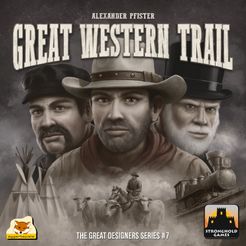The only surprise about seeing it's been a little over two years since the last post is that wasn't a hell of a lot longer. So I figured, if I'm going to try this again, I may as well get off to a positive start, and what's more positive than games about giant slabs of beef?
NOT THAT BEEF
NOT THAT BEEF
Yes, thank you.
The whole idea behind Great Western Trail is that you're a cattle rancher from Texas trying to sell cattle in Kansas City and locations westward. Like any good rancher, you want victory points more than money, because victory points indicate the joy of your work that goes beyond mere capitalist interests. But the stationmaster in Kansas City is all, "Fuck your victory points," because he's a joyless prick, so as the game progresses it's necessary to sell better and better herds in order to make it worth shipping them farther west if you don't want them to be stuck in KC.
This is a game that's fairly easily learned, but not easy to describe without explaining how it works, so here goes: You start out with a cowboy, a train, and a deck of cattle cards.
- The deck is what you draw from to create the herd that will be sold once you make it to KC; your goal here is to have as many different types of cattle in your hand as possible, because each type only counts once.
- The cowboy moves up to four spaces (this can be increased later), and can make use of whichever building he stops on each turn. Important note: only spaces with something on them (buildings or hazards) count against the movement limit, so early on it's possible to run your cowboy from Texas to KC in just a couple of turns. As the game progresses and buildings are put up in the blank spots on the board, the cowboy can't go as far each turn unless you upgrade his movement.
- The train is, I guess, something you're invested in as a cattle rancher? Certain buildings will let you move your train car forward, and certain abilities can force it back as well. The farther forward it is, the cheaper it is to ship your cattle to more distant cities.
At the beginning of the game, there are only seven buildings on the board. These allow for the basic mechanics--hiring more workers, putting up buildings, trading in cattle for money along the way (this is the main method for manipulating your hand in order to have different cattle types when you reach KC), buying more cattle, etc. Right away you're forced to prioritize. Do you stop in to hire workers? Put up a building while there are more spaces available? Four of the seven neutral buildings let you trade in cattle for money and draw new cards. How necessary is that for you? If you have three 2s and a 1--the best possible hand with the base deck--do you race to KC for the quick money and make use of more buildings on the next trip through?
Prioritization gets more complicated as the game goes along and the board fills... kind of. You end up with more options overall as you place buildings, but you're not allowed to use your opponents' buildings; all they do is slow your movement and, in some cases, make you pay the player who owns that building a coin or two. You also never see buildings that let you hire more workers or construct more buildings apart from the neutral ones that are available from the start. So you end up having to decide what you can (or need to) accomplish to max out the money and points you're earning while not having that many more options compared to the start, unless you focus hard on hiring craftsmen and putting up buildings every chance you get.
That doesn't mean you're working around the same few goals the whole game, though, which brings us to the strength/weakness of the game: the absolutely fucking bananas number of ways to score points. You don't count points until the end, but once you're there, there are eleven different things to score. They give you a score pad, but still, that's a lot of possibilities to keep track of while you're playing. You can't possibly chase them all, but you'll have to go for more than one to have a chance, so sometimes a strategy might come down to how many different possibilities you can keep track of, in order to take advantage of the ones that become most readily available. It could be owning station master tokens, fulfilling more objective cards, buying better cattle and pulling together more VPs at the end by hitting the furthest-west stations, and it could also involve synergy between the goals you're chasing or just getting stuff that all adds up to a bunch of points on their own.
You know what, though? It works. It doesn't feel as overwhelming as it could, even as a first time player, although being a board game vet helps a lot. This might not be the game you want to convince your boyfriend that board games are actually a lot of fun and he should play them with you more often, unless you only like two-hour-plus games that require mucho consideration to maximize the effects of each turn. At least then you're being honest with him about what he'll be getting into playing with you.
Score: Eleven jumbo bags of Great Value peppered beef jerky out of twelve.


No comments:
Post a Comment